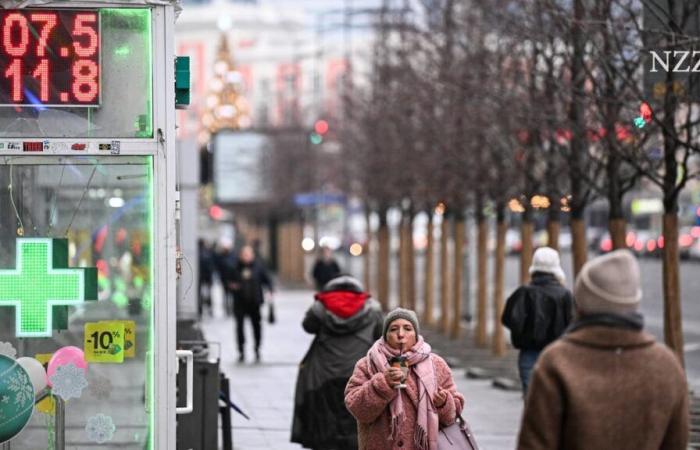The Russian currency has come under pressure following new sanctions against the banking sector. The problems of the war-oriented Russian economy are increasing.
The dollar rate is posted at an exchange office near the center of Moscow.
Alexey Maishev / Imago
Few things have been as consistent over the past three decades of the Russian market economy as the value of the ruble’s exchange rate against the dollar and, in recent years, against the euro. Economy and society are guided by this, even after the major attack on Ukraine and the falling out with the West. The electronic boards with red writing are part of the street scene. They provide quite good information about the state of the Russian economy.
Stability and upswing with downsides
In the past few days, a real collapse in exchange rates has been observed – on Wednesday alone the ruble lost 8.5 percent against the dollar. The rate set by the Central Bank was 108 rubles for one dollar. This is the lowest value since March 2022, when the Russian financial system was confronted with Western sanctions. It was true that financial stability was secured at the time thanks to drastic interventions by the central bank. But the stability and economic boom that has gripped Russia, not least thanks to enormous investments in the war against Ukraine, are only the surface. There is turbulence underneath.
The trigger for the rapid fall in share prices was the US decision to put Gazprombank on the sanctions list. Until then, it had been the largest Russian bank to remain unaffected by American sanctions. Raw material exports were processed through them. The bank became Russia’s main institution for international payments.
Because the sanctions mean that Russia is no longer properly integrated into the international financial system, the foreign currency that comes into the country is crucial. Now this is no longer possible via Gazprombank. As a result, the dollar and euro have become even more scarce commodities. The price decline began in the summer after the Moscow Stock Exchange, the most important place for foreign exchange transactions, was also subject to sanctions. Since then, the ruble has been traded over the counter. The determination of the course has become more arbitrary.
The state is satisfied
The government does not seem to be unhappy about the price development. Finance Minister Anton Siluanov said this week that this was good news for the export economy. Their products become cheaper and they earn more. The Russian treasury also benefits from this because it receives more rubles for the raw materials sold in dollars. Given the record high levels of government spending, this suits the government. However, the sufferers are the importers, who are already suffering from the difficult conditions for logistics and payment transactions, and, as a result, also the consumers.
Inflation will continue to be fueled. The population is already groaning under this. Appliance and electronics stores have already increased prices. In October, seasonally adjusted inflation was 8.5 percent. However, for individual everyday goods it is much higher. The headlines have been made by butter prices, which have increased by more than 25 percent since the beginning of the year. In some regions butter was increasingly stolen from supermarkets. Potatoes, a staple food, have cost over 50 percent more since the beginning of the year. The wages, which have risen due to the labor shortage, are not keeping up.
High interest rates put a strain on companies
The central bank doesn’t have too many resources to intervene. On Wednesday evening it announced that it would no longer buy foreign currencies until the end of the year. This eliminates a major buyer. This already seemed to have an effect on Thursday: the price stabilized. In the event of a comparable exchange rate collapse in August 2023, the monetary authorities raised the key interest rate sharply as an emergency and obliged exporters to convert a large part of their foreign exchange income into rubles.
The key interest rate is currently 21 percent and could be raised again in December because inflation cannot be slowed down. Mortgage interest rates are as high as 30 percent. With its strict monetary policy, the central bank is exposing itself to sharp criticism, especially from the corporate world. The business association called for the central bank’s independence in interest rate policy to be curtailed. An entrepreneur recently complained that it was more lucrative to put money in the bank than to invest. That ruins the future.
The numbers indicate a temporary end to the boom and a slowdown in the economy. There is still no threat of a crash. But some economists are already seeing the danger of stagflation – stagnation coupled with uncontrollable high inflation. These are all consequences of an economy that is restricted externally by sanctions and internally focused on arms spending.






